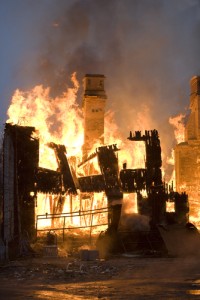In May, we reported that a New York court had found that a policy containing both an exclusion for water that backs up through sewers and drains and a coverage grant for accidental discharge or overflow from a plumbing system was neither internally inconsistent nor ambiguous in nature. The post can be found here. On June 17th, Oklahoma’s highest court agreed, albeit without citing the New York case, and it held that the two provisions were fully reconcilable and enforceable. The case in question is Porter v. Oklahoma Farm Bureau Mut. Ins. Co., 330 P.3rd 511, 2014 Okla. LEXIS 72 (Okla., June 17, 2014).
 Justin and Brandy Porter owned a home that was damaged when raw sewage entered the premises on November 14, 2009. Their homeowners carrier was Oklahoma Farm Bureau Mutual Insurance Company, and the insurer denied. Litigation followed. After the district court granted Oklahoma Farm Bureau’s motion to dismiss and the state’s intermediate level appellate panel affirmed, the Oklahoma Supreme Court granted the Porters’ writ of certiorari.
Justin and Brandy Porter owned a home that was damaged when raw sewage entered the premises on November 14, 2009. Their homeowners carrier was Oklahoma Farm Bureau Mutual Insurance Company, and the insurer denied. Litigation followed. After the district court granted Oklahoma Farm Bureau’s motion to dismiss and the state’s intermediate level appellate panel affirmed, the Oklahoma Supreme Court granted the Porters’ writ of certiorari.
The contract of insurance afforded all risk coverage for real property loss but covered loss to personal property on a specified perils basis. One of the specified perils enumerated was:
Accidental Discharge or Overflow of Water or Steam from within a plumbing, heating, air conditioning or automatic fire protection sprinkler system[.]
With respect to both real and personal property, the policy also excluded loss caused by “water damage meaning . . . water which backs up through sewers or drains[.]” Read more ›

 The Frys owned a home in Fleetwood, Pennsylvania. The house was a wood-frame structure with a stone veneer, and they noticed that the veneer was bulging in 2003. An engineering report that they commissioned at the time attributed the problem to “an insufficient number of veneer wall ties and fasteners,” and the Frys paid $22,000 to have the exterior wall repaired.
The Frys owned a home in Fleetwood, Pennsylvania. The house was a wood-frame structure with a stone veneer, and they noticed that the veneer was bulging in 2003. An engineering report that they commissioned at the time attributed the problem to “an insufficient number of veneer wall ties and fasteners,” and the Frys paid $22,000 to have the exterior wall repaired. The Brancos’ home was damaged by a sinkhole in April of 2010, and they made claim under a homeowner’s policy issued by Homewise Preferred Insurance Company. The insurer denied liability, asserting that what had happened did not qualify as a “sinkhole loss” as defined, and the Brancos brought suit. Homewise was subsequently declared insolvent, and Mr. and Mrs. Branco filed an amended complaint substituting the Florida Insurance Guaranty Association as defendant.
The Brancos’ home was damaged by a sinkhole in April of 2010, and they made claim under a homeowner’s policy issued by Homewise Preferred Insurance Company. The insurer denied liability, asserting that what had happened did not qualify as a “sinkhole loss” as defined, and the Brancos brought suit. Homewise was subsequently declared insolvent, and Mr. and Mrs. Branco filed an amended complaint substituting the Florida Insurance Guaranty Association as defendant. The case involved sinkhole damage to a piece of property owned by Cannon Ranch Partners, Inc. The property was insured by Cincinnati Insurance Company, and the contract of insurance included coverage for sinkholes. The dispute involved the necessary scope of repair. Cincinnati’s two consultants determined that grouting was all that was needed to restore the structure to its pre-sinkhole state, but Cannon Ranch’s consultant opined that underpinning was also needed, and the policyholder entered into a contract to have that done. Cincinnati refused to sign off on the work, however, and it made a demand for appraisal instead.
The case involved sinkhole damage to a piece of property owned by Cannon Ranch Partners, Inc. The property was insured by Cincinnati Insurance Company, and the contract of insurance included coverage for sinkholes. The dispute involved the necessary scope of repair. Cincinnati’s two consultants determined that grouting was all that was needed to restore the structure to its pre-sinkhole state, but Cannon Ranch’s consultant opined that underpinning was also needed, and the policyholder entered into a contract to have that done. Cincinnati refused to sign off on the work, however, and it made a demand for appraisal instead. The case arose after the Office of Thrift Supervision closed Vantus Bank and appointed the FDIC as its receiver. The FDIC then filed suit against the bank’s former officers and directors, alleging gross negligence and breach of fiduciary duties. Progressive Casualty Insurance Company, which had issued a D&O policy to the bank, responded by filing a declaratory judgment action of its own, asserting that there was no coverage for the FDIC’s claims under its contract of insurance.
The case arose after the Office of Thrift Supervision closed Vantus Bank and appointed the FDIC as its receiver. The FDIC then filed suit against the bank’s former officers and directors, alleging gross negligence and breach of fiduciary duties. Progressive Casualty Insurance Company, which had issued a D&O policy to the bank, responded by filing a declaratory judgment action of its own, asserting that there was no coverage for the FDIC’s claims under its contract of insurance. The Curries were the owners of a home in Langhorne, Pennsylvania. When Superstorm Sandy struck on October 29, 2012, the structure took a direct hit from a tree on the property. The insurer, State Farm Fire & Casualty Company, conducted an inspection and then tendered its repair estimate to the policyholders together with a check for $56,940.54 – the actual cash value of the estimate less the policy’s deductible. The Curries responded by submitting their own repair estimate in the amount of $363,804.98. State Farm then conducted a new inspection and made a supplemental payment of $9,502.09.
The Curries were the owners of a home in Langhorne, Pennsylvania. When Superstorm Sandy struck on October 29, 2012, the structure took a direct hit from a tree on the property. The insurer, State Farm Fire & Casualty Company, conducted an inspection and then tendered its repair estimate to the policyholders together with a check for $56,940.54 – the actual cash value of the estimate less the policy’s deductible. The Curries responded by submitting their own repair estimate in the amount of $363,804.98. State Farm then conducted a new inspection and made a supplemental payment of $9,502.09. Effective March 16, 2010, Colony Insurance Company issued a commercial property policy providing $4.5 million in coverage for a vacant, 95,000 sq. ft. building in Montezuma, Georgia. In light of the vacancy, the insurer insisted that the policy include a protective safeguards endorsement requiring that the policyholders maintain an automatic sprinkler system, fire extinguishers, and functioning utilities and reciting that Colony would “not pay for loss or damage caused or resulting from fire if, prior to the fire, [the insureds] [f]ailed to maintain any protective safeguard . . . in complete working order.” The policyholders’ application for coverage also recited that the utilities in the building were on. When the insurer had the structure inspected in early April, however, the utilities were all found to be shut off.
Effective March 16, 2010, Colony Insurance Company issued a commercial property policy providing $4.5 million in coverage for a vacant, 95,000 sq. ft. building in Montezuma, Georgia. In light of the vacancy, the insurer insisted that the policy include a protective safeguards endorsement requiring that the policyholders maintain an automatic sprinkler system, fire extinguishers, and functioning utilities and reciting that Colony would “not pay for loss or damage caused or resulting from fire if, prior to the fire, [the insureds] [f]ailed to maintain any protective safeguard . . . in complete working order.” The policyholders’ application for coverage also recited that the utilities in the building were on. When the insurer had the structure inspected in early April, however, the utilities were all found to be shut off. The case arose after Lewayne Greene moved into a retirement community, vacating her home in Irving, Texas and placing the structure on the market. She notified her insurer of the move, but she did not purchase an endorsement offered by the carrier, Farmers Insurance Exchange, that would covered an extended vacancy. Four months later, fire from a neighboring house spread to her home and damaged it. Farmers denied the subsequent insurance claim because the structure had been vacant for over sixty days, and the policyholder brought suit. She prevailed in the trial court, but the Court of Appeals reversed and rendered judgment for Farmers. On appeal, a unanimous Texas Supreme Court affirmed.
The case arose after Lewayne Greene moved into a retirement community, vacating her home in Irving, Texas and placing the structure on the market. She notified her insurer of the move, but she did not purchase an endorsement offered by the carrier, Farmers Insurance Exchange, that would covered an extended vacancy. Four months later, fire from a neighboring house spread to her home and damaged it. Farmers denied the subsequent insurance claim because the structure had been vacant for over sixty days, and the policyholder brought suit. She prevailed in the trial court, but the Court of Appeals reversed and rendered judgment for Farmers. On appeal, a unanimous Texas Supreme Court affirmed.
 Plaintiff Hamilton Properties acquired the Dallas Plaza Hotel in 2006 and mothballed the structure in February of 2009. The hotel was insured by American Insurance Company (AIC) from February through September of 2009. In 2012, the policyholder notified AIC that it was making claim for roof and water damage allegedly sustained during a July 8, 2009 storm that dumped ping-pong sized hailstones on the city. After investigating the loss, the insured denied liability, and Hamilton Properties brought suit.
Plaintiff Hamilton Properties acquired the Dallas Plaza Hotel in 2006 and mothballed the structure in February of 2009. The hotel was insured by American Insurance Company (AIC) from February through September of 2009. In 2012, the policyholder notified AIC that it was making claim for roof and water damage allegedly sustained during a July 8, 2009 storm that dumped ping-pong sized hailstones on the city. After investigating the loss, the insured denied liability, and Hamilton Properties brought suit.